'Blonde' Is Garish, Unfair, and No Fun At All
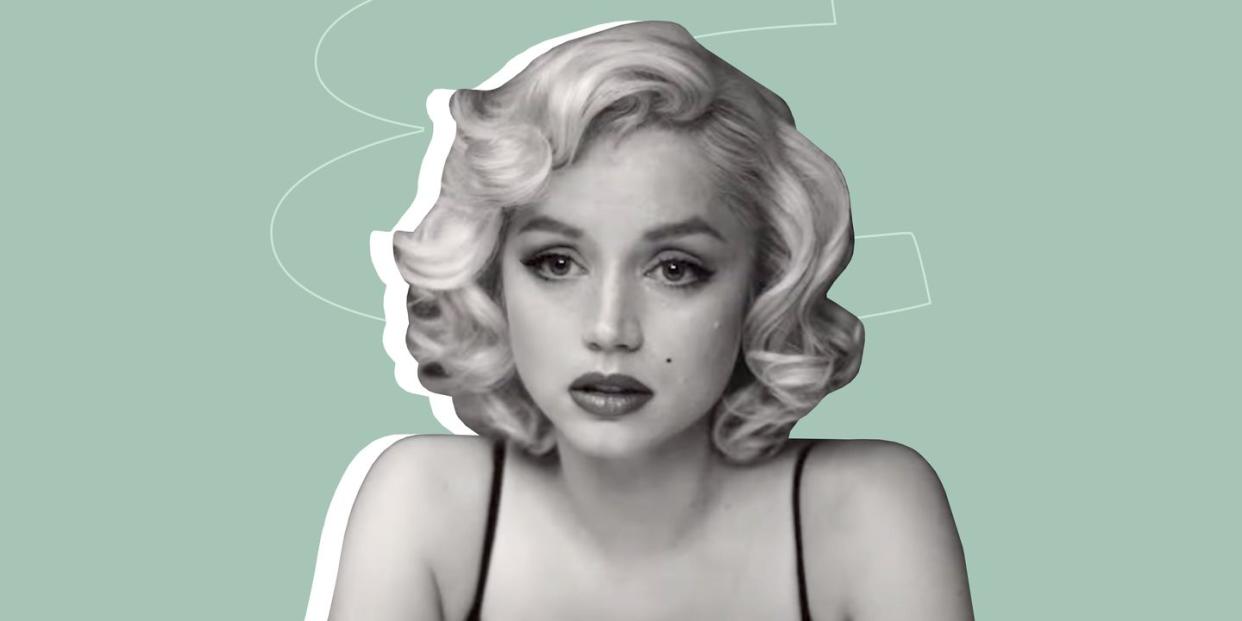
- Oops!Something went wrong.Please try again later.
“Watched by all. Seen by none.” That’s the tag line on the poster for Andrew Dominik’s Blonde, the director’s . . . what? fugue-state reverie? necrology? . . . of Joyce Carol Oates’ reimagining of the myth of Marilyn Monroe.
None?
Not one of the directors who provided the roles that brought out her incandescence, what George Cukor called “her absolutely unerring sense of comedy,” or the others who, in Don’t Bother to Knock and especially in the astounding Niagara found something hard, dark, mean? Not any of the photographers, male and female, who, creating some of the most indelible images of the 20th Century, often spoke of her more as a collaborator than as a camera subject? Not Whitey Snyder, the loyal friend who did her makeup from her first screen test at Twentieth Century Fox in 1946 to her funeral in 1962? Not any of her husbands in any private moment? Not Arthur Miller’s father, who Marilyn called every week even after her divorce from his son? Not one of the moviegoers who, from the time she made her presence felt in cheesecake photos and then in movies right up the moment you are reading with, has never ceased to delight in this singular creature?
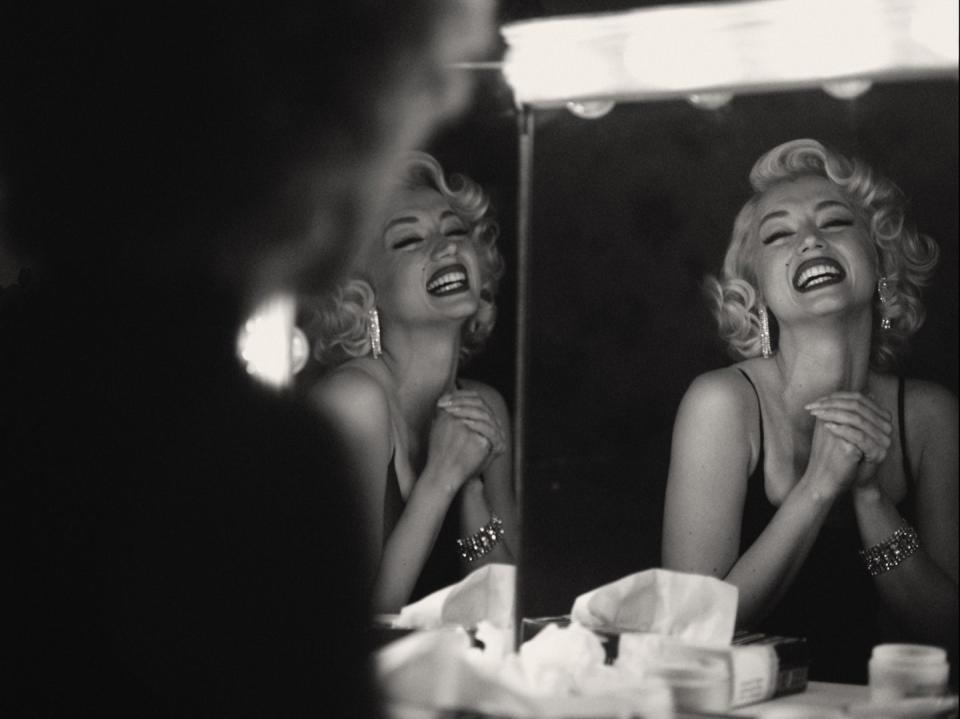
I don’t know if it’s possible to create a savior fantasy in which the whole point is that the protagonist is doomed but it’s the hubris of both Dominik, who adapted the novel as well as directed and, in that novel, Oates to position themselves as the ones who are able to get past the fantasies and slanders of the studio moguls and directors and paparazzi and gossip columnists and hangers on and pimps and controlling husbands and see poor Marilyn—sorry, Norma Jeane—for who she was. And what do they see? A woman who spent her life searching for the father she never had, haunted by the abandonment of a mother who went mad.
No kidding. That’s what they’ve come up with.
Blonde, laid out in shifting aspect ratios and film stock, distorted lenses, switching from color to black & white, is a garish expressionistic illustration of what was already in Oates’ novel: claptrap Freudianism, victimization feminism, and the moral shock over the squalidness of Hollywood that, whether it’s being sold via scandal sheets or novels with a literary pedigree, never fails to attract people who want to indulge their own sanctimonious voyeurism. Oates, the most morbid of celebrated American writers, has always filtered her tabloid sensibility through a cold high-Gothic approach that affords her literary cache while fending off charges of sensationalism. It’s a decidedly anti-sensual approach and particularly unsuited to a figure as sensual as Marilyn Monroe—unless your goal is to depict Marilyn as nothing but a victim trafficked by powerful men and then used up by us, the public who, going to her movies, thrilled by her photo shoots, charmed or turned on or just made happy by the fact of her, were little more than her johns.
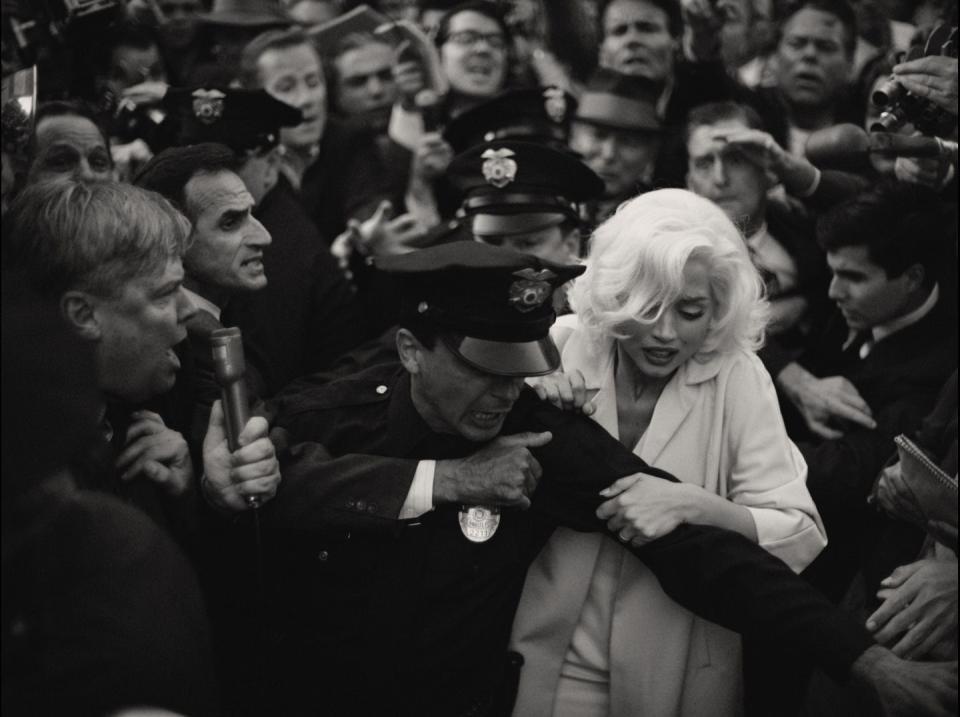
Blonde proceeds through a flash-card chronology in which Marilyn, played by Ana de Armas, is used or abused by, in turn, her mad mother; the studio system (when she goes for her interview at 20th Century Fox with Darryl Zanuck he rapes her); the two sexually ambiguous sons of Hollywood stars—Charlie Chaplin, Jr. and Edward G. Robinson, Jr.—who form a throuple with Marilyn while using her for what they can get; her second husband, Joe DiMaggio, played by Bobby Cannavale and referred to in the movie’s mythic terms as “the Ex-Athlete” who regards her movie career as little more than prostitution; her third husband, Arthur Miller (“the Playwright”) played by Adrien Brody, who worries about what being married to a sex symbol does to his intellectual status; and of course the public, never presented as individuals who, by themselves, might act rudely or kindly or starstruck but as a uniformly voracious and threatening mass.
When Oates recreated the famous New York City nighttime location shoot for The Seven Year Itch where Marilyn stood on the subway grating while her dress was blown up around her, she described it like the climactic scene in The Day of the Locust (the touchstone Hollywood novel for people who hate Hollywood), a movie premiere that turns into a riot. As Oates wrote it, it was a human sacrifice in the making. The one person in the crowd who doesn’t want to devour Marilyn, DiMaggio, beats her when she returns to their hotel because he thinks she displayed herself like a whore.
Dominik shoots the scene in much the same way. It’s one of several times in the movie where the crowds turned out to see Marilyn, here overwhelmingly men, are shot in harsh glaring black-and-white, their open screaming mouths distended to appear like maws, like the onlookers in a Wedge photo. The movie tells us that Marilyn is being exploited for the sake of this rabble. But who’s doing the exploiting when Dominik sticks his camera up Marilyn’s dress so that de Armas’s behind fills the screen (giving us a view no one on Lexington Avenue and 52nd St had on that night in 1954)? Who’s doing the exploiting when, in a later scene, Marilyn is summoned to New York to service JFK and, as the President pushes her head down onto his crotch, there is a repeated shot of de Armas, eyes tearing and nearly gagging as her head bobs up and down in the frame?
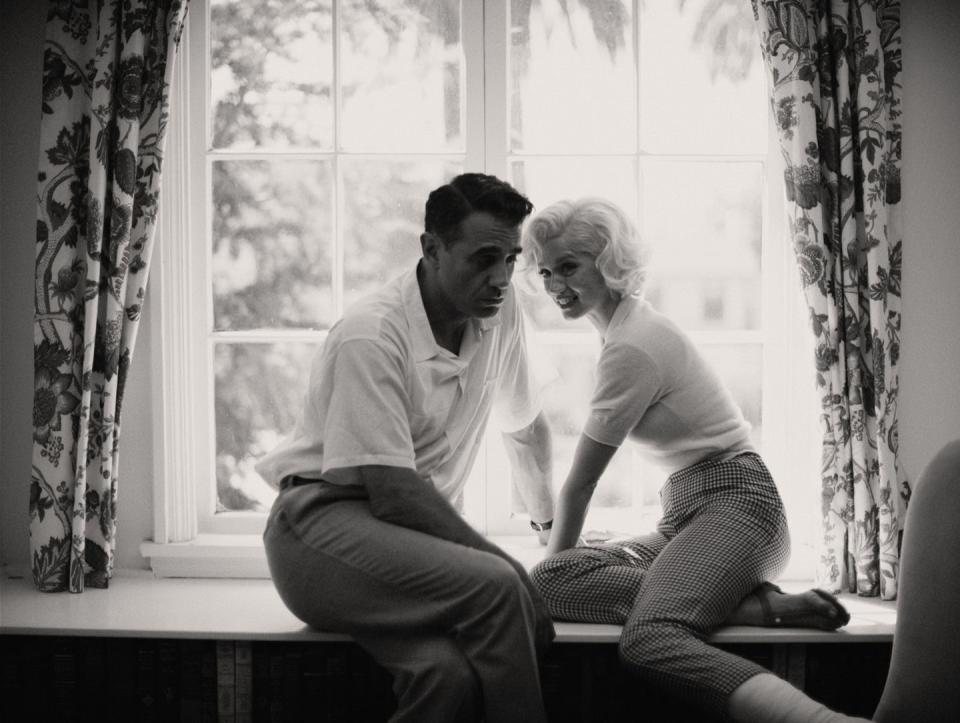
I’m not doubting that Marilyn was subjected to all kinds of boorish behavior or that JFK treated her as callously as any of his other trophy lays. My argument is not with what Blonde is about—the exploitation of this singular star—but with how it’s about what it’s about. We see Marilyn, having undergone an abortion in order to star in Gentleman Prefer Blondes, saying of the acclaim showered on her at the movie’s premiere, “For this I killed my baby?”, surely a line to confirm every certainty in Samuel Alito’s meager little soul. It’s not that there’s something inherently retrograde about suggesting a woman might regret having an abortion but when we’re given a line like that, or later when Marilyn is expecting Miller’s baby and Dominik introduces a talking fetus—I swear to God—asking if mommy will kill him too, the movie is dealing in the cheapest Operation Rescue tactics.
Blonde has been talked about as if it were going to be Ana de Armas’s breakout role and I wouldn’t trust anybody who’s seen her work before this and not been excited by the prospect of what’s to come. Her sequence in No Time to Die, both when she’s engaging in badinage with Daniel Craig and then joining him to fight off the bad guys, showed a real sense for play. She made everything she did look like a good time, and she suggested that she might be one of those rare movie presences who’s at her sexiest when being funny. Here, her rendition of the breathy Marilyn voice we know from the movies and her physical bearing in the photographs and film sequences that Dominik recreates are often startlingly precise. But there’s no room for her to play beyond those imitations. De Armas has been directed to play Marilyn as if Marilyn were a Marilyn Monroe character. And that is the film’s point. Blonde wants us to believe Marilyn has been swallowed up by the screen persona, leaving nothing behind but gestures and inflections. This Marilyn is a breathless doll who exists solely as a plaything for the powerful.
So you can’t feel insulted for her when a casting director scorns her claim that she’s read Dostoevsky or when Miller thinks she’s been fed a line comparing one of his plays to Chekov (you’d have to be fed a line to make that claim). Dominik, though, seems to think we will be, not seeing his far greater insult. De Armas has some fine moments when Marilyn prepares to speak in auditions, when you feel her summoning the power to make the scene real, and when Marilyn and Miller first meet, she and Brody are allowed an extended scene in which they can connect with each other and communicate the pleasure in this unexpected introduction without any interference from Dominik. But de Armas has been given a thesis to play, not a character. Her screen glories will come. They aren’t here.
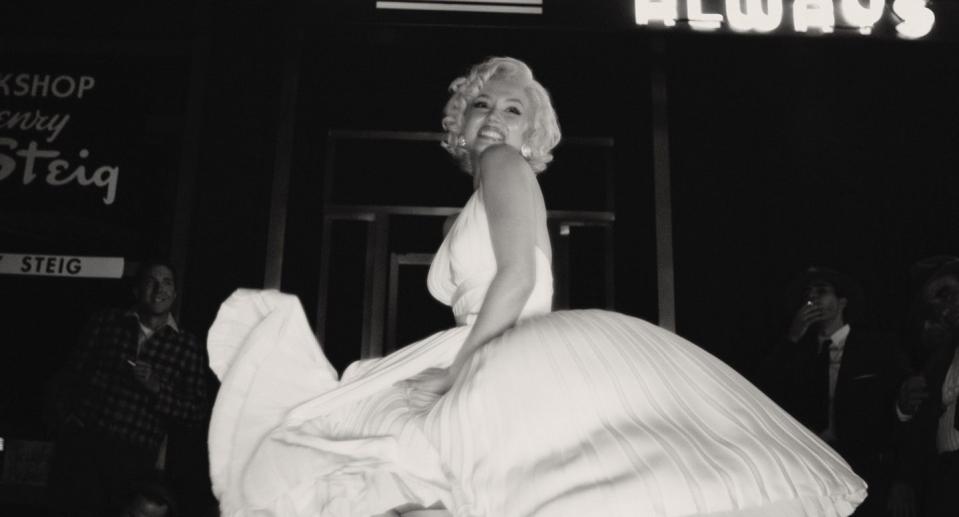
Blonde, both movie and book, seem awfully taken by the notion that “Marilyn Monroe” was a creation. Do Oates and Dominik think the movies are meant to be real? And don’t they understand just how real the movies can seem? In one of the greatest films ever made, Alfred Hitchcock’s Vertigo, a detective falls in love with a woman and then, when she dies, tries to remake her in another woman. The detective finds out the woman he loved never really existed in the first place, she was made up to lure him into a plot. And yet he’s real to her. He’s held her in his arms and kissed her. And for us in the audience who have only seen this woman as shadows and light projected on a screen, she’s no less real. Of course, Marilyn Monroe was made up and of course she was real. That’s what art is—the fictive, the created striking a chord in us to produce real emotion. Would Oates think the characters in her novels are less because they’re fictions? And why is Dominik, a movie director, buying into this nonsense?
Perhaps the most remarkable thing about Blonde, book and movie, is that neither Oates or Dominik seem to even like Marilyn that much. There is scarcely a mention of a performance in Oates’s novel unmarked by the scorn she pours on how the film was received by the crude public. Marilyn can’t even sneak disguised into a theater to watch The Seven Year Itch without being driven away by a man masturbating a few seats over from her. And in a remarkably revealing interview with Dominik in the current issue of the British film magazine Sight & Sound, the interviewer Christina Newland writes in her intro that Dominik “seems genuinely gobsmacked when I tell him many of my friends and colleagues watch—and enjoy— Gentlemen Prefer Blondes (1953), which he regards, like most of Monroe’s films, as what he calls “cultural artefacts.” A director still early in his career regards the work of, among others, Howard Hawks, Billy Wilder, Henry Hathaway, and John Huston as no more than cultural artefacts? Jump up and down Andy and let us hear ‘em clank together.
Oates’s novel is 738 pages in its current paperback edition. Dominik’s movie is two hours and forty-six minutes. Those respective lengths are not the result of an expansive vision or a gathering cumulative force. They are the result of their creators’ determination, by sheer volume and repetition, to bludgeon the audience into accepting their puny, constricted view of Marilyn Monroe. There isn’t, in a page of Oates’ novel or a moment of Dominik’s film, that contains a laugh, a smile, a grace note. And yet they put forth this grinding grimness in what seems clearly intended to be a feminist statement.
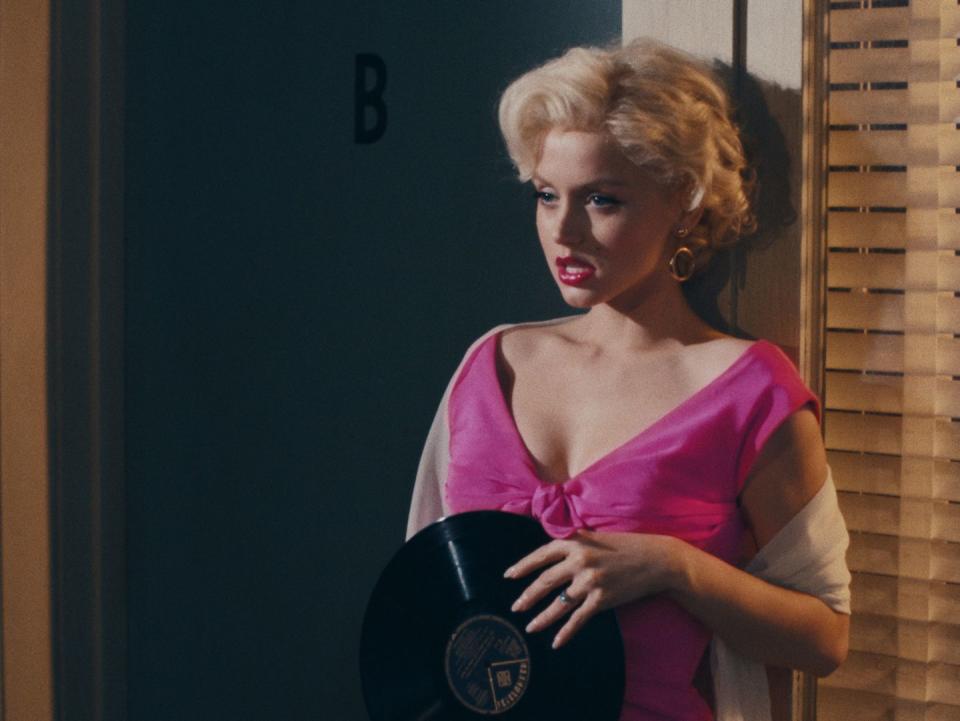
But when you deny a character’s capacity for pleasure and joy; when, her famous fragility notwithstanding, you take away every bit of her ability to make her own decisions; when (as Newland confronted Dominik with) you leave out the facts that Marilyn started her own production company, that she publicly supported Miller when he was being hounded by HUAC, that she used her celebrity to get Ella Fitzgerald a headlining engagement in a Hollywood club when Black singers weren’t given those gigs; when you reduce her talent to nothing more than lewd sex jokes and tawdry exploitation; when you insist that the happiness and pleasure and yes, the love that people have felt for her for seventy years is nothing more than the collective gross appetite of the lumpen; when you put forth that view even though your protagonist is one of the most famous women in the world and the public record is there to refute you; when you reduce someone’s artistry to the machinations of a dumb-bunny sex robot then who is it that’s using Marilyn Monroe to fulfill their fantasies and prejudices and favored shibboleths? Among the many not-very-bright things Dominik says in that Sight & Sound interview, there’s this: “She was the Aphrodite of the 20th century, the American goddess of love. And she killed herself. So what does that mean?” Clearly, for both Dominik and Oates, it means that Marilyn died for our collective sexist sins. I’ll be damned if I accept any vision of Marilyn Monroe from these two, both so eager to perform their own sordid crucifixion.
You Might Also Like

